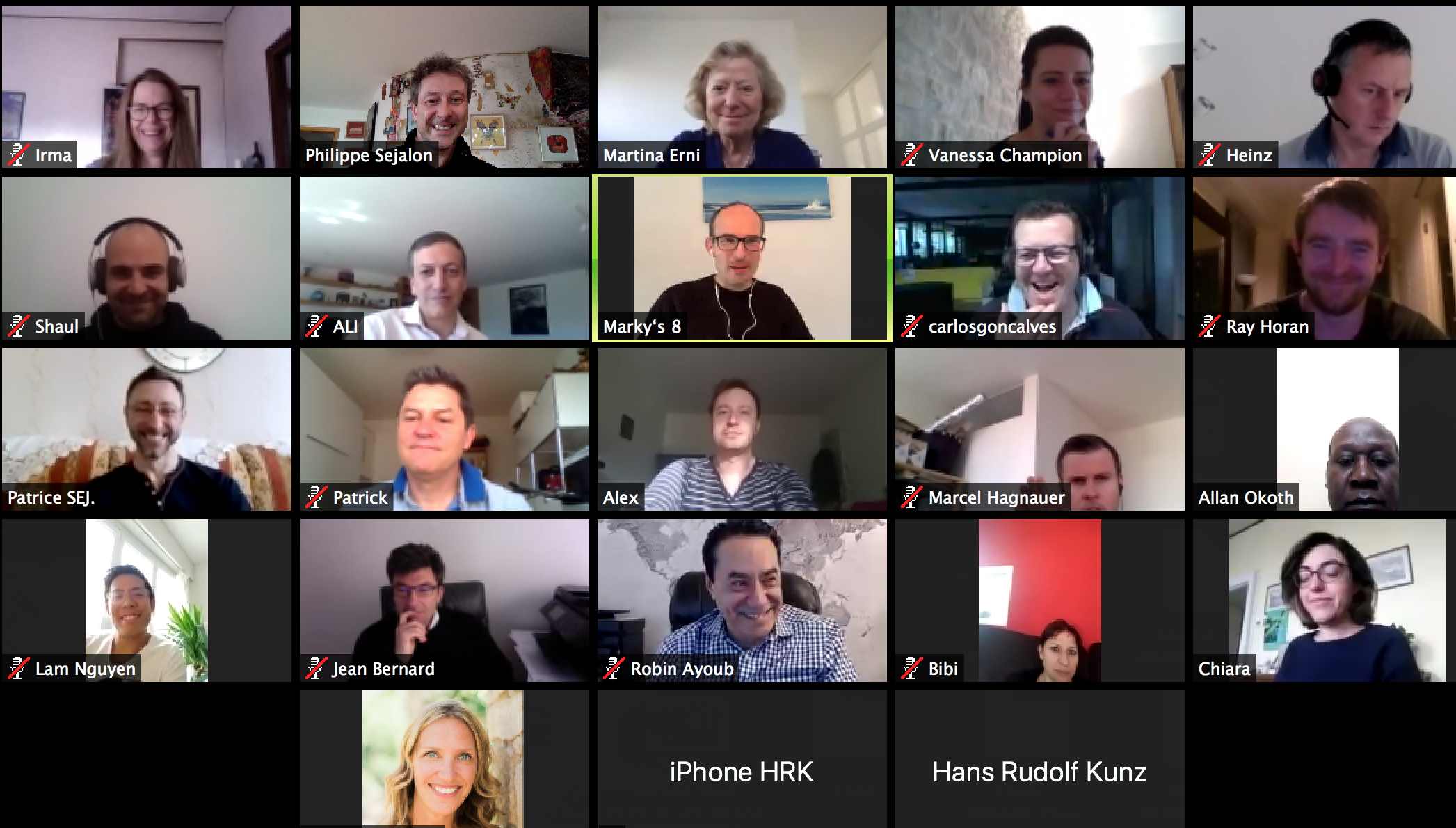Online Learning for Insurance – Join our LinkedIn Group
The purpose of this group is to share information and our experience about e-learning in the insurance industry.
Come and join us at https://www.linkedin.com/groups/8980498/
Looking forward! 🙂
The purpose of this group is to share information and our experience about e-learning in the insurance industry.
Come and join us at https://www.linkedin.com/groups/8980498/
Looking forward! 🙂


Some of our team members are participating to this weekend Hackathon.
The European Commission, led by the European Innovation Council and in close collaboration with the EU member states, will host a pan-European hackathon to connect civil society, innovators, partners and investors across Europe in order to develop innovative solutions for coronavirus-related challenges
For more information, see https://euvsvirus.org/
Let us know if you want to join us!
Our team at INGAGE organizes “Bring Your Own Drink” sessions every 3-4 weeks with colleagues and friends around the world.
Each time, we have a Special Guest leader in a field who shares insights about a key global challenge (Blockchain, Human Rights and Technology, Virtual Reality, etc.) followed by quick updates from some of our team members around the world.
While we do have some “serious” but exciting topics, these sessions are first of all meant to spend a good time together in this period of global confinement due to COVID-19.


Many of you have been very supportive over the past few years and we would be happy to welcome you to our future sessions. We have a large group every time and due to many requests, please contact me to make sure you’re included in our event. Cheers ?
Healthcare providers and other institutions need support in different ways to fight the virus and take care of patients.
Many volunteers are willing to help, but they might not have the necessary knowledge.
You probably have heard about the Pareto Principle.
The Pareto principle states that for many outcomes, roughly 80% of consequences come from 20% of causes (the “vital few”).[1] Other names for this principle are the 80/20 rule, the law of the vital few, or the principle of factor sparsity.[2][3]
Management consultant Joseph M. Juran developed the concept in the context of quality control, and improvement, naming it after Italian economist Vilfredo Pareto, who noted the 80/20 connection while at the University of Lausanne in 1896.[4] In his first work, Cours d’économie politique, Pareto showed that approximately 80% of the land in Italy was owned by 20% of the population. The Pareto principle is only tangentially related to Pareto efficiency.
Mathematically, the 80/20 rule is roughly described by a power law distribution (also known as a Pareto distribution) for a particular set of parameters, and many natural phenomena have been shown to exhibit such a distribution.[5] It is an adage of business management that “80% of sales come from 20% of clients”.[6]




Guest Author: Juan D’Alessandro
Las Compañías de Seguro comienzan a poner los datos a trabajar para ofrecer a sus clientes productos innovadores. La ciencia de los datos, impulsa la automatización de procesos repetitivos y provee más conocimiento para, al final del día, ofrecer un servicio personalizado a los clientes aumentando su satisfacción y relación con la marca.
Para empezar, vamos a repasar que es la Inteligencia Artificial. En 1956, John McCarthy acuñó la expresión «inteligencia artificial» como «la ciencia e ingenio de hacer máquinas inteligentes, especialmente programas de cómputos que reúne características y comportamientos asimilables al de la inteligencia humana. Una definición mas actual que se adapta a la realidad es la siguiente: la capacidad de un sistema para interpretar correctamente datos externos, para aprender de dichos datos y emplear esos conocimientos para lograr tareas y metas concretas a través de la adaptación flexible.
Sin duda, adoptar una estrategia integral sobre el manejo de la información es vital para garantizar el correcto funcionamiento de los modelos desarrollados y su resultado. Este es el principal desafío de las compañías. Recolección, transformación, clasificación y almacenamiento es esencial para poner en practica estos modelos. El origen de los datos pueden ser fuentes externas como redes sociales o internas (formularios, histórico de siniestros y primas).
Algunos casos de impacto de esta tecnología en la industria:
Estos son solo algunos ejemplos propios de la industria. También existen productos ya operativos en otras industrias (fintech, ecommerce) que se están adoptando como Chatbots, Manejo de recursos humanos, etc.




Guest Author: Juan D’Alessandro
La semana pasada cerro con una noticia alarmante para Lloyds y el resto de companias de seguros. Un fallo de la corte suprema de UK, sentencio que los comercios deberán cobrar por la perdida de beneficio ocacionada por los lock-downs ordenados por los distintos gobiernos a causa de covid.
En forma unánime, la corte sustento su decisión en ampliaciones de cobertura ambiguas respecto a su relación directa con un dano material como son enfermedad e impedimento de accesos. De esta forma, desactivaron el principal argumento de las aseguradoras que es la no existencia de dano material.
El impacto de esta medida se estima en $1.6billones. Ahora resta esperar que sucederá en otros países donde estamos viendo demandas y procesos similares.
https://www.insurancejournal.com/news/international/2021/01/15/597643.htm




Guest Author: Juan D’Alessandro
Compartimos a continuación un articulo donde Zurich presente este innovador producto que apunta tanto a dueños como a contratistas. En tiempos donde los eventos de la naturaleza son cada vez mas frecuentes y mas devastadores, el producto recientemente lanzado en Estados Unidos es una solución complementaria al ya tradicional TRC. De esta forma se logran cubrir aquellas demoras que puedan surgir luego de un evento catastrófico, aunque no haya un daño material al Proyecto.
Este tipo de seguros paramétricos requieren la definición del evento y los órganos de medición que dispararan la cobertura. Por ejemplo, ráfagas de viento sostenidas de determinada velocidad o milímetros de lluvia caídos en determinado tiempo.
Ejemplos de eventos que podrían estar cubiertos por este producto serian la falta de suministro de agua o electricidad, el impedimento de acceso por arboles caídos en los caminos o inundaciones.
Interesante debatir respecto a la posibilidad de implementar este tipo de cobertura en Latinoamérica, subjetividades y consideraciones propias de la geografía e idiosincrasia local.
INGAGE offers a range of engaging out-of-the-box online courses for the insurance industry as well as bespoke courses.
As you might know, INGAGE is THE Training platform for the Insurance Industry.
What do we offer to our clients?
Engaging out-of-the box as well as bespoke online training.
Our product range includes a complete “Online Academy in-a-box”, e-courses (such as fraud management), the Insurance Simulator, board games…
Who exactly are our clients?
Leading insurance companies, reinsurance companies or brokerage firms as well as Small and Medium Enterprises in the insurance industry.
Have you heard a lot about blockchain, but still wonder how it works?
In this video, Anders Brownworth shows what a blockchain looks like, how “hashing” enables security and, in short, how it actually works. This is a video that you will quite probably find highly interesting if you are new to the topic!
Thanks to Ali Hauser, INGAGE CEO for Latin America, for this amazing business trip to London! After the ones in Zurich, it’s now the leading companies in London’s famous “City” that welcome our company’s products with a strong interest. Fantastic acceleration! We will need more talents to join us soon… ![]()
![]()

